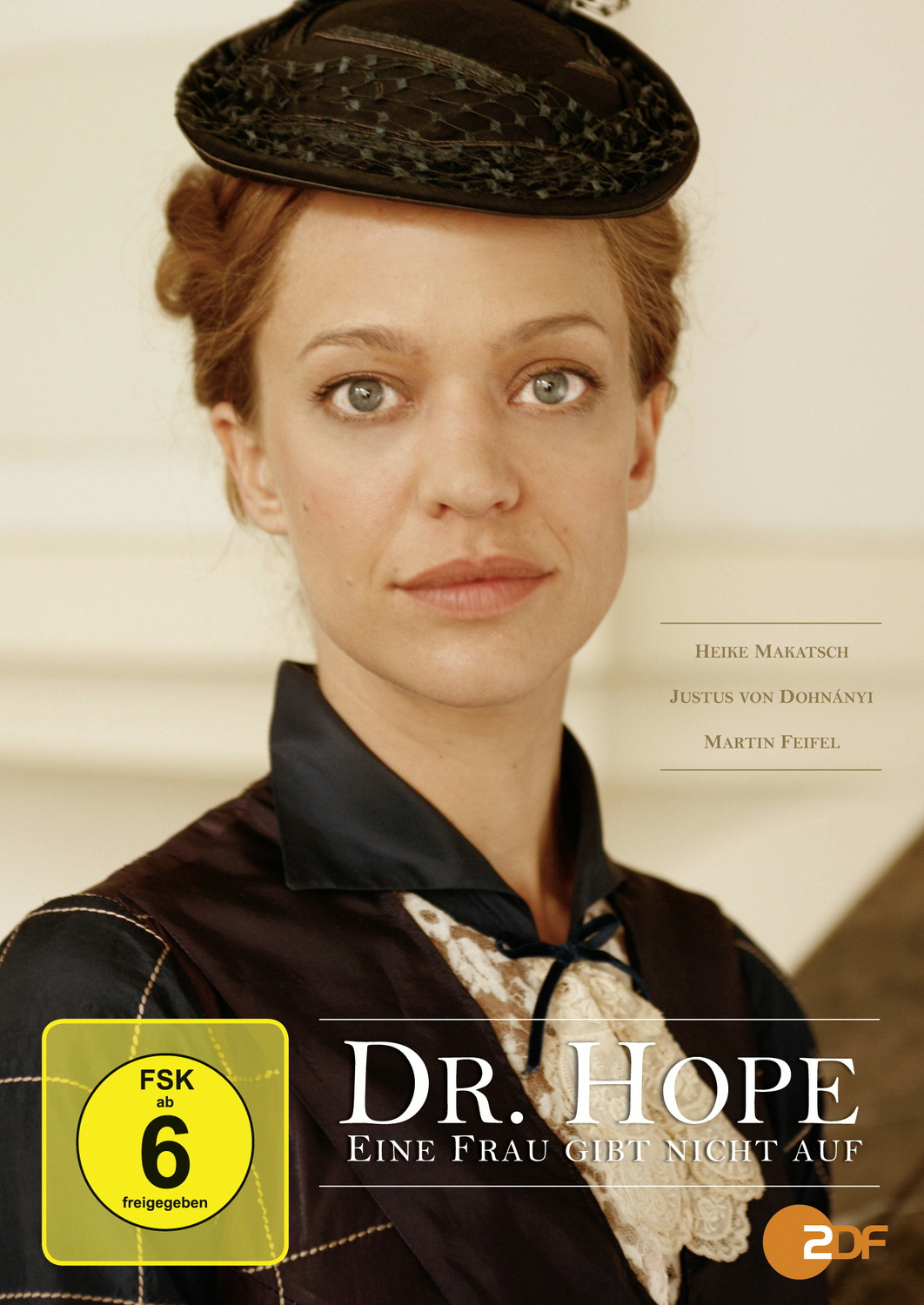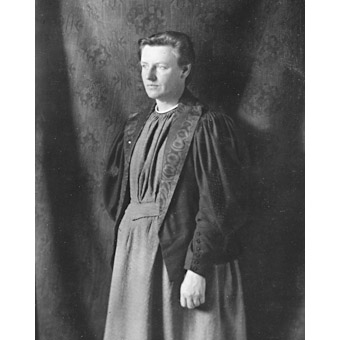
Dr Hope – A Woman
Does Not Give Up – a mini-series in two
parts – is the English title of a historical drama which premiered on German television (ZDF) in 2009.
It is based on a true story: the life and
career of Hope Bridges Adams Lehmann, who was the first female doctor of medicine in Germany.
Here are some basic facts about this drama:
*** German title: Dr Hope: Eine Frau gibt nich auft
*** Director:
Martin Enlen
*** Writers:
Torsten Dewi, Katrin Temple, and Christoph Callenberg
*** Soundtrack:
German – no English subtitles
*** Released on DVD: 2010*** Part 1 = 89 minutes
*** Part 2 = 85 minutes
*** Total run time = 174 minutes
Hope was born and raised in England. When her father dies - in 1872 - she and her mother move to Germany. They settle in Leipzig. Hope declares that she wants to study medicine in order to become a doctor. But in the newly-established German state, this is not possible.

The cast includes
the following:
** Heike Makatsch
as Dr Hope Bridges Adams Lehmann (1855-1916)
** Justus von
Dohnanyi as Dr Otto Walther (1855-1919) – Hope’s first husband
** Martin Feifel
as Dr Carl Lehmann (1865-1915) – Hope’s second husband
** Inka Friedrich
as Clara (Eissner) Zetkin (1857-1933) - revolutionary activist
** Tatjana Blacher
as Ellen Bridges Adams (born Kendall) – Hope’s mother
** August Zirner
as Ludwig von Arnstetten – professor of medicine
Since this movie
is based on a true story, the basic facts are part of the public record. They
are not secret. Therefore I feel free to mention some of them here. If you wish
to know more about the main characters, you can simply google their names.
PART ONE
This movie is a biography of Hope Bridges Adams Lehmann, who was the first doctor of medicine in Germany. In this movie we follow her life and career during more than four decades: from 1872 to 1916.
This movie is a biography of Hope Bridges Adams Lehmann, who was the first doctor of medicine in Germany. In this movie we follow her life and career during more than four decades: from 1872 to 1916.
As stated above, there are two episodes:
** Part one covers the time 1872-1889
** Part two covers the time 1889-1916
Hope was born and raised in England. When her father dies - in 1872 - she and her mother move to Germany. They settle in Leipzig. Hope declares that she wants to study medicine in order to become a doctor. But in the newly-established German state, this is not possible.
Higher education
is reserved for men. Being a doctor is regarded as unnatural for a woman. A
women is supposed to get married, have children and take care of her family.
But Hope does not
want to follow the traditional way. When she is turned away, she refuses to
take no for an answer, and in the end she is allowed to study and to take her
exam. However, since she does not have a German high school diploma, which is
only for boys, she is for many years not allowed to call herself a doctor (she does not get
this right until 1904).
Hope is married
two times: Her first husband is Otto Walther; her second husband is Carl
Lehmann. Both are doctors.
Hope and Otto run
a medical clinic in Frankfurt am Main. Later they open a sanatorium in
Schwarzwald. The sanatorium is for patients who suffer from tuberculosis.
Hope and Carl run
a medical clinic in München (known as Munich in English).
Among Hope’s
friends we see Clara Eissner, who is better known as Clara Zetkin.
In 1914, when
World War One breaks out, Carl volunteers. He dies in 1915. Hope dies in the following
year, 1916.
PART TWO
What do reviewers say about this movie? On IMDb it has a rating of 62 per cent, which corresponds to three stars on Amazon. If you ask me, this average rating is too low.
What do reviewers say about this movie? On IMDb it has a rating of 62 per cent, which corresponds to three stars on Amazon. If you ask me, this average rating is too low.
On the German
version of Amazon there are 16 reviews of this product. The average rating is
4.9 stars. If you ask me, this average rating is too high.
The story is
captivating, dramatic, and emotional. In addition, it is based on a real
person. It is interesting to follow the life and the career of this pioneer woman.
As you can see, there
is much to like in this movie, but it is not perfect. There are some flaws,
which cannot be ignored. In the following I will try to explain what is wrong.
(1) As the story
moves forward, step by step, on-screen messages tell us the time and the place
of each new scene. But the dates offered are often wrong:
** In the movie,
the sanatorium opens in 1889. In the real world this did not happen until 1891
** In the movie,
Hope divorces Otto and marries Carl in 1890. In the real world this did not
happen until 1896
** In the movie,
Hope’s Handbook for Women is published in 1899. In the real world this book
was published three years before, in 1896
(2) Historical
facts are often changed; and some interesting historical facts are eliminated:
** In a scene that
is set in 1875, Hope and Otto are visiting a restaurant. A young man hands
out leaflets about a meeting. The young man is identified as Carl Lehmann. But
this is impossible, because Carl was born in 1865, ten years after Hope. In 1875
he was only ten years old, he was just a boy, not a handsome young man. When we
are watching the movie, we may find it interesting that Hope here catches a
glimpse of her second husband before she has even married her first husband.
But in the real world this episode never happened.
** In the movie,
Hope and Otto have only one child, a daughter, whose name is Mara. In the real
world, Hope and Otto had two children: Heinz, who was born in 1884, and Mara,
who was born in 1886. The son has been eliminated from the script. Why?
** According to
the movie, Mara stayed with her father in Schwarzwald, when her parents
divorced, and Hope had no contact with her for several years. In the real world
things were quite different: both children lived with Hope and Carl in Munich
during the school year, while they stayed with their father during school
holidays.
** In the movie,
the sanatorium is located in Kirchheim. In the real world it was located in
Nordrach.
** In the movie,
Clara (Eissner) Zetkin studies medicine together with Hope. In the real world,
Clara Zetkin did not study medicine.
** When Hope and
Carl lived in Munich, they were part of the socialist left-wing movement. For a
while, this circle included the well-known Russian revolutionary Lenin. Hope met and knew
Lenin when he was living in Germany. But this interesting fact has been
eliminated from the script. Why?
I do not
understand why the writers felt they had to change historical dates and
historical facts in this way. As far as I can see, it does not serve any useful
purpose. It does not make the story better in any way. I do not understand what
is wrong with the historical truth.
Why is it better when Hope and Otto have
only one child instead of two? Why are we not allowed to know that Hope met and
knew Lenin while he lived in Germany?
The changes made by the writers do not
make any sense. They merely distort the facts. They violate historical truth
for no good reason.
CONCLUSION
I like this movie and I want to give it a good rating. But I have to remove one star because of the flaws mentioned here. Therefore I think it deserves a rating of four stars (80 percent).
I like this movie and I want to give it a good rating. But I have to remove one star because of the flaws mentioned here. Therefore I think it deserves a rating of four stars (80 percent).
PS # 1. For more
information, see the following books by Marita Krauss:
** Die Frau der Zukunft: Dr. Hope Bridges Adams
Lehmann, 1855-1916 – Ärztin und Reformerin (2002)
** Hope: Dr. Hope Bridges Adams Lehmann – Ärztin und
Visionärin: Die besondere Biografie (2009)
PS # 2. The following articles are available online:
** Oliver Hochkeppel,
”Von Lenin zu Unsinn,” Süddeutsche Zeitung, 18 September 2009, page 41
** Katja Sebalt, “Allein
under Männer,” Der Spiegel, 18 March 2010
PS # 3. The German historian Marita Krauss accused the
writers of the screenplay of plagiarizing. She claimed they had stolen their
information about Dr Hope and the people around her from her books.
For a while
there was a real danger that the movie would not be shown on television because
of this controversy. In the end the problem was solved when the producers
agreed to pay Marita 15,000 Euros.
For more details, see Sandra Kegel, “Die Zeit
wird mir recht geben,” Frankfurter Allgemeine Zeitung, 19 March 2010 (available
online).
*****

Hope Bridges Adams Lehmann (1855-1916)
(this photograph is from 1896)
*****
No comments:
Post a Comment